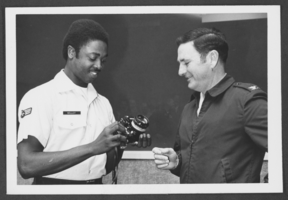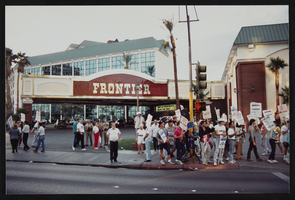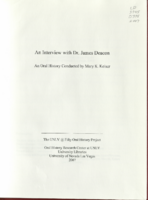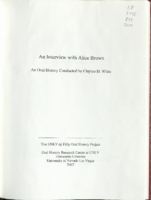Search the Special Collections and Archives Portal
Search Results

Transcript of interview with Jerome "Jerry" Jay Vallen by Lisa Gioia-Acres, October 2, 2007
Date
2007-10-02
Archival Collection
Description
Jerome Jerry Jay Vallen was born and grew up in Philadelphia, Pennsylvania. His father was in the restaurant business and Jerry worked for him throughout his teens and young adulthood. He and his two brothers entertained themselves during their childhood years by going to the library and reading. This was a legacy of the Depression era, when there simply wasn't any money to spare for extraneous expenses. Jerry's first jobs were bellman / assistant manager in a small hotel; auditor, and then property manager at the Pine Tree Point Club. He attended Penn State for a year (working in his dad s restaurant the whole time) and then transferred to the hotel school at Cornell University. After a stint in the armed forces during the Korean War, he returned home and used the GI bill to finish his master's degree. He started on his doctorate, but it would be 20 years before he completed it. After getting married (1950) and starting a family, Jerry and his wife Flossie realized that the restaurant business and family life did not mix well, so he decided to stay in education. Fie spent several summers at the University of Pennsylvania in their graduate school of business and in 1966, interviewed with Jerry Crawford, provost at UNLV. Jerry and his family moved out to Las Vegas in June of 1967, leaving northern New York during a blizzard and arriving four days later in southern Nevada to find tulips blooming. They decided they liked Las Vegas, found a house right away, and settled in to their new life. Jerry taught marketing in the hotel college at the beginning of his career and for several years thereafter. Boyce Phillips took the rooms division and George Bussel taught foods. Their main focus was to attract students, and they worked on making it easier tor students to transfer from out of state. Jerry also thought it was extremely important that the hotel college be independent of university administration control. Dr. Vallen has 5 or 6 books published, including 3 textbooks that he continues to update, and an oral history of the hotel college completed shortly after he retired in 1989. Today he and his wife travel and enjoy twice yearly gatherings with their family.
Text
#68585: Flower on campus taken for the possible use in the Boyd Law School art project April 28, 2012 at the University of Nevada, Las Vegas, 2012 April 28
Level of Description
File
Archival Collection
University of Nevada, Las Vegas Creative Services Records (2010s)
To request this item in person:
Collection Number: PH-00388-05
Collection Name: University of Nevada, Las Vegas Creative Services Records (2010s)
Box/Folder: Digital File 00
Collection Name: University of Nevada, Las Vegas Creative Services Records (2010s)
Box/Folder: Digital File 00
Archival Component
#72201: Sociology major Camisha Fagan participated in the McNair summer research program. Her project consists of key informant interviews and a systemic literature, 2018 August 02
Level of Description
Item
Archival Collection
University of Nevada, Las Vegas Creative Services Records (2010s)
To request this item in person:
Collection Number: PH-00388-05
Collection Name: University of Nevada, Las Vegas Creative Services Records (2010s)
Box/Folder: Digital File 01
Collection Name: University of Nevada, Las Vegas Creative Services Records (2010s)
Box/Folder: Digital File 01
Archival Component
#69230: UNLV Howard R. Hughes College of Engineering hosts Project Lead The Way for middle school teachers August 7, 2013 at the University of Nevada, Las Vegas, 2013 August 07
Level of Description
File
Archival Collection
University of Nevada, Las Vegas Creative Services Records (2010s)
To request this item in person:
Collection Number: PH-00388-05
Collection Name: University of Nevada, Las Vegas Creative Services Records (2010s)
Box/Folder: Digital File 00
Collection Name: University of Nevada, Las Vegas Creative Services Records (2010s)
Box/Folder: Digital File 00
Archival Component

Photograph of Sargeant Leroy Kelley, Jr. and Colonel William Strand, Nellis Air Force Base, Nevada, March 22, 1976
Date
1976-03-22
Archival Collection
Description
Left to right: Sgt. Leroy Kelley, Jr., Photojournalist of the Year, and Col. William Strand, Nellis Air Force Base, Nevada. Site Name: Nellis Air Force Base (Nev.)
Image
Hollywood Roosevelt Hotel "Grandfather's Follies with Allan Cole": Florentine Gardens magazine and hotel receipt, 1949 July 22
Level of Description
File
Archival Collection
Maria LaCavera Papers
To request this item in person:
Collection Number: MS-01139
Collection Name: Maria LaCavera Papers
Box/Folder: Box 01
Collection Name: Maria LaCavera Papers
Box/Folder: Box 01
Archival Component

Transcript of interview with Julie Brinkerhoff-Jacobs by Stefani Evans, September 30, 2016
Date
2016-09-30
Archival Collection
Description
When Julie Brinkerhoff-Jacobs talks about the landscape architecture firm her parents, Barbara and Don Brinkerhoff, began in their home in 1958, she brightens and leans in. Since joining her parents’ firm in 1982, Julie gradually assumed responsibility for Lifescapes International’s sales, marketing, financial management, and strategic planning and serves as President and Chief Financial Officer. Here, Brinkerhoff-Jacobs talks of her life before joining and outside of Lifescapes: her family; her youth; her charity, HomeAid; her leadership activities; and her personal interests. Her focus, though, is Lifescapes and the Las Vegas people and the iconic projects that not only altered the ways that visitors perceive Southern Nevada but also changed the business of Lifescapes. “Not just in Las Vegas, but around the world people hire us because of what we've done in Las Vegas.” For Julie, one of the greatest joys of working alongside her parents was discovering them as peers—learning to know them as two people who “chose to live an incredibly artistic life together.” Her mother passed in 2014, but Julie and her father continue to work with and learn from each other.
Text

Frontier Strike: civil disobedience, traffic blocking, arrests, Culinary Union, Las Vegas (Nev.), 1991 September 28 (Folder 1 of 2), image 22
Date
1991-09-28
Description
Arrangement note: Series I. Demonstrations, Subseries I.A. Frontier Strike
Image

Transcript of interview with Dr. James Deacon by Mary K. Keiser, August 24, 2006
Date
2006-08-24
Archival Collection
Description
James Deacon was born at home in White, South Dakota. For the first few years of his life, the family moved around a lot to accommodate his father's job as school superintendent. Their summers were spent in a cabin on a lake, where Jim helped his grandparents in their store, seining minnows, clerking, and putting up ice. From his eighth grade year through high school graduation, the family lived in Aberdeen, which was the largest city (population 25,000) they had lived in Jim attended college on a tuition scholarship in Wichita Falls, Texas. He majored in biology and education, and then went to grad school at the University of Kansas. His favorite undergraduate professor knew the fish expert there and encouraged Jim to study fish. Instead of completing a master's degree, Jim went straight into the Ph.D. program. He graduated in the summer of 1960, and started applying for jobs. He interviewed with Dean Bill Carlson for a job at UNLV, which was then called University of Nevada Southern Regional Division. In 1964, Jim and his family moved to Reno and he taught two summers at UNR. As professor of biology, Jim focused on getting students involved in field studies as well as classroom work. He was instrumental in organizing the Department of Environmental Studies, which started in 1992. He also helped develop a master's program and a Ph.D. program in biology. He is best known for his expertise and involvement in the study of the Devil's Hole pup fish, an endangered Nevada species of fish.
Text

Transcript of interview with Alice Brown by Claytee D. White, October 19, 2005
Date
2005-10-19
Archival Collection
Description
Alice Brown, former UNLV librarian, was born in Cleveland, Ohio. She gives a thorough and fascinating history of her family going back to the 1600s and includes a detailed description of the family home, which may have served as a stop on the antislavery Underground Railroad. Alice attended college in Pennsylvania and earned a library degree at Carnegie. After Pearl Harbor, she enlisted in the Women's Army Auxiliary Corps and served in the U S. and overseas. Upon discharge from the Army, she worked as assistant children's librarian in Cleveland Heights for a time and then followed a friend out to Tacoma, Washington. She worked in the Tacoma Public Library as children's librarian, and also met her husband there. Alice's husband was offered a job in Henderson, Nevada, at the manganese plant. That didn't work out, but he was hired at Titanium right away. Alice describes Henderson as it was in the fifties, and also discusses the state of the libraries in both Henderson and Las Vegas. After the birth of her third child, Alice began working at the University of Nevada Southern Regional Division (now UNLV) part time. This was in 1962, and Alice shares detailed memories of the university campus, library, and faculty and staff from that era. Alice did not slow down after her retirement in 1985. She did volunteer work, traveled, and attended classes at UNLV. Today she volunteers at the Clark County Heritage Museum as a cataloger and at the hospital helping deliver papers and lab work to their various destinations.
Text
Pagination
Refine my results
Content Type
Creator or Contributor
Subject
Archival Collection
Digital Project
Resource Type
Year
Material Type
Place
Language
Records Classification
